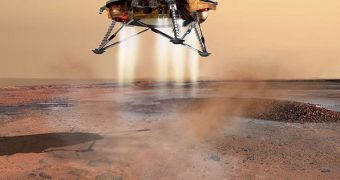Scientists at the American space agency say that they managed to derive new data from the information sent back by the Phoenix Mars Lander mission. They say that water and tectonic activities may have existed on the Red Planet more recently than originally thought.
The investigators say that the lander managed to identify evidence to support the idea that water interacted with the Martian surface a few million years ago.
The exact same thing was proven for tectonic activity as well. The reason why this is important is that tectonics generally proves a planet is still active.
In the case of Earth, volcanoes and earthquakes indicate that the planet's core is still spinning, that the mantle is still liquid and hot, and that protective magnetic fields are still being produced.
When plate tectonic stop here, all data seem to indicate that Earth will become a desolate, barren planet, that can no longer support complex life.
The Phoenix spacecraft arrived on the surface of our neighboring planet on May 25, 2008, and managed to endure at the northern latitudes where it landed until September of the same year.
After that, its solar panels no longer received sufficiently large amounts of sunlight, which in turn prevented it from operating properly.
Listening campaigns conducted with the Mars Odyssey at the beginning of the year showed extensive damage on Phoenix, and did not manage to pick up any signals.
But what the lander did was paint a clearer image of the carbon dioxide (CO2) cycle, which makes out about 95 percent of the Martian atmosphere.
“Atmospheric carbon dioxide is like a chemical spy. It infiltrates every part of the surface of Mars and can indicate the presence of water and its history,” explains expert Paul Niles.
He holds an appointment as a space scientist at the Houston, Texas-based NASA Johnson Space Center.
“Isotopes can be used as a chemical signature that can tell us where something came from, and what kinds of events it has experienced,” Niles goes on to say.
Phoenix was able to conduct very detailed measurements of the isotopes present in the Martian atmosphere, and could also track down specific isotopes of carbon and oxygen.
Details of the investigation appear in Thursday's online issue of the top journal Science. Niles was the lead author of the research.
Though Phoenix is dead, analysts say, its datasets have yet to be thoroughly analyzed.

 14 DAY TRIAL //
14 DAY TRIAL //